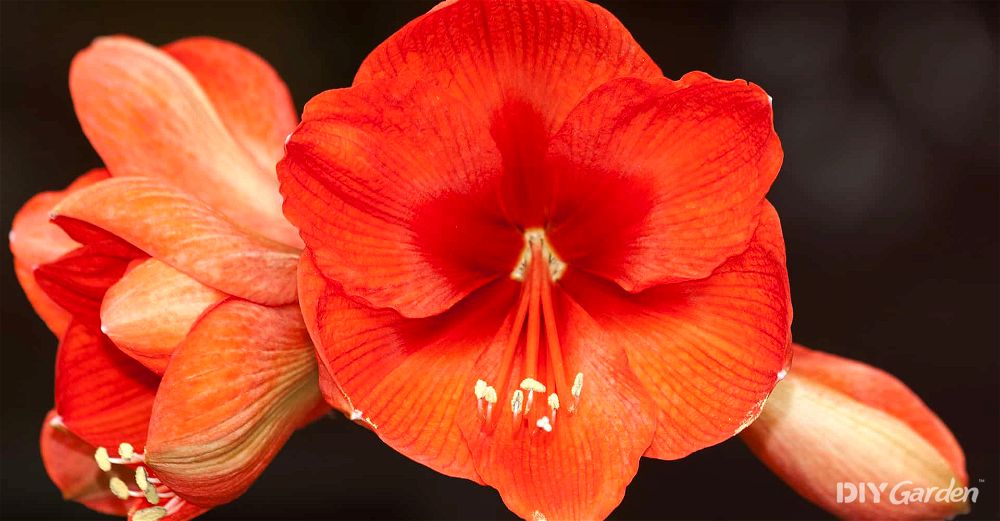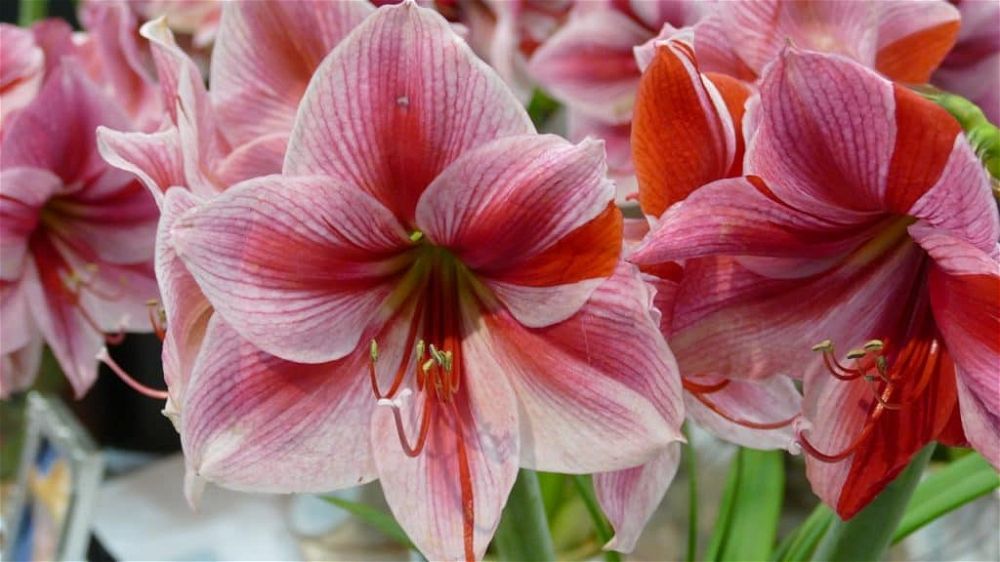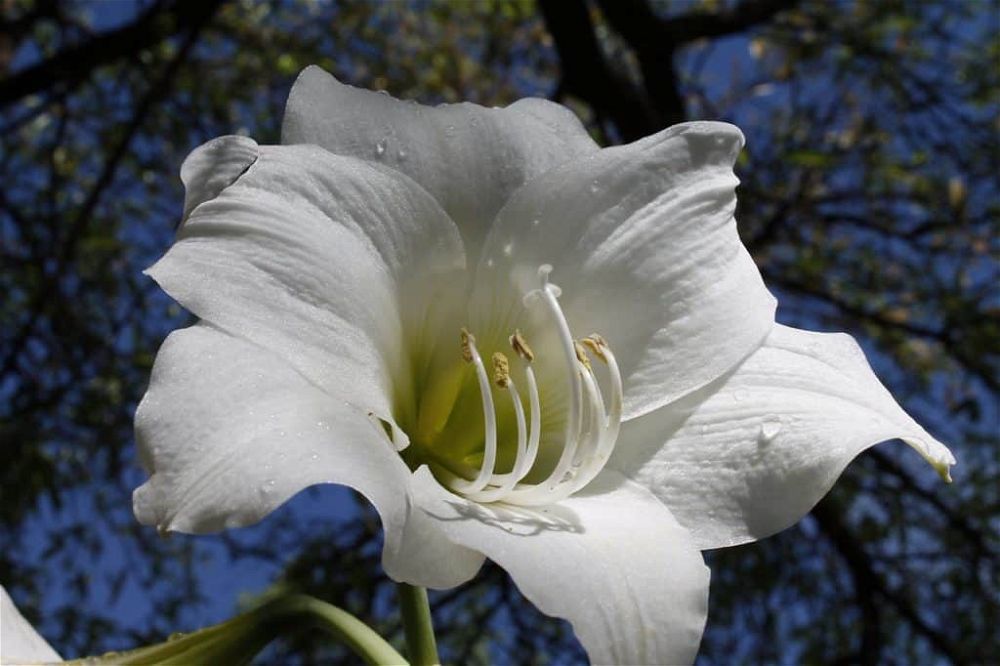
Jump to a Section
Plant Overview
| Common Name | Amaryllis, Knight's-star-lily |
|---|---|
| Scientific Name | Various species of Hippeastrum |
| Plant Family | Amaryllidaceae |
| Origin | South and Central America and the Caribbean |
| Height | Up to 90cm tall flower spikes |
| Light | Bright but not direct sunlight |
| Temperature | Keep around 20°C and reduce to 15°C to 18°C when flowering |
| Hardiness | Tender |
| Soil | John Innes No.2 or peat-free multipurpose compost |
| Fertiliser | High potassium house plant or tomato fertiliser |
| Propagation | Seed or bulb offsets |
| Pests | Rare, though bulb scale mite or large narcissus bulb fly possible |
| Difficulty | Easy |
The glossy, strap-shaped leaves and striking trumpet flowers of Amaryllis bring welcome colour and brightness to the home in the depths of winter gloom. Provided the bulb is planted at the right time, the spectacular flowers will bring additional cheer to the Christmas table to complement the mulled wine and roast turkey.
There is confusion in the horticultural world about the name. The true Amaryllis belladonna, sometimes grown in UK gardens as the ‘naked lady’, belongs to a genus that hails from South Africa. The ‘Christmas’ indoor Amaryllis derives from a family of 90 species that originate from the Americas. They were separated by experts into the genus Hippeastrum in 1987, but the original name has stuck, and the confusion remains! This article is about growing and caring for the magnificent Amaryllis bulb that has become one of our most popular Christmas house plants.
The name Hippeastrum is said to come from the resemblance of the flower to a knight’s morning star, a familiar flailing medieval weapon, from the Greek ‘hippeus’ (knight) and ‘astron’ (star).
Hippeastrum species have been selectively bred since the early nineteenth century to produce a huge variety of large, colourful flowers. In the UK, these need to be raised as house plants for the winter, though the pots can be placed outside in the summer, and – if allowed a dormancy period – they can be brought back inside to flower once again in the following winter.
Amaryllis Care
Amaryllis bulbs bought from a garden centre or supermarket should be carefully checked to ensure firmness and good condition. Soft bulbs may be showing the first signs of rot, or may have been stored inappropriately. Select the larger bulbs, as these tend to produce more flowers. Keep the bulbs in a cool, dry place until planting time.
Bulbs can be planted from October through to March, and staggered plantings can be used to produce a succession of blooms to provide a centrepiece for the table right through the winter. The bulbs generally flower approximately six to eight weeks after planting, so the end of October is the target planting date for Christmas colour.
Most supermarket plants come complete with pot and compost, but for loose bulbs, choose a pot that is just deep and big enough to give the roots room, but to keep the plant confined. For an average single bulb, select a pot that is 20cm deep and around 4cm wider than the bulb itself. Ensure that the pot has plenty of drainage holes, and cover these with sturdy broken crocks to retain the compost and to give the pot some stability – the plants can get a little top-heavy when in full bloom.
Before planting the bulb, rehydrate its roots by placing it on top of a jar or cup of warm water so that only the roots get wet. The base of the bulb itself should be kept clear of the water. Leave the roots to soak like this for approximately an hour.
Meanwhile prepare the compost for planting. Mix a handful of perlite into some John Innes No. 2 or multipurpose potting compost, add a layer into the bottom of the pot and moisten. Only the bottom two-thirds of the bulb will need to be covered, so adjust the depth of the layer accordingly. Once rehydrated, gently tease and spread the roots and place the bulb onto the compost. Backfill around the bulb with the rest of the compost, remembering to keep the top third of it clear of the compost.
Place the pot in a brightly lit position at around 21°C and water regularly but sparingly until the new leaves develop. Once the leaves are growing well, increase the amount of water given, but never waterlog the compost and allow any excess water to drain from the base of the pot. Apply a balanced house plant liquid fertiliser once a week.
When the flowers start to open, move the pot to a slightly cooler position, ideally around 18°C, but still with plenty of light. This will extend the life of each flower. Plants on windowsills will naturally grow towards the light, so turn the pot a few times each day to ensure that the stem continues to grow straight upwards. Varieties with large flowers may benefit from staking with a cane.
Each individual flower will last a couple of weeks before turning brown. Cut off each bloom as it fades, and then when the entire stem has finished, cut the whole thing back down to its base, just above the bulb.
With a little tender loving care, the plant can be kept to flower again the following year. To achieve this, keep the leaves growing by continued watering, and use a house plant fertiliser occasionally. The container can be moved to an unheated greenhouse or placed outside in a sheltered position once frosts have passed. Stop watering and feeding at the end of August, and when the leaves start to turn yellow cut them back to around 5cm from the top of the bulb. Keep the bulb in the pot and move it to a cool but frost-free place such as a shed or garage, ideally at around 10°C, for at least two months so that it becomes dormant. By bringing the pot back indoors and re-starting the watering and feeding cycle, the bulb can be persuaded to flower again some 6 weeks or so later.
Light requirements
Keep growing Amaryllis plants in a bright, warm, sunny place, ideally at about 20°C, away from open windows or other sources of draughts.
Watering
Water the compost frequently but sparingly. Do not allow it to dry out completely but avoid overwatering, and do not leave the pot standing in a tray of excess water.
Soil conditions
Amaryllis do best in a rich and well-drained compost such as John Innes No. 2 with a good handful of perlite or horticultural grit.
Fertilisers
Feed weekly with a good quality, high potash house plant fertiliser or liquid tomato fertiliser when the flower start to appear.
Repotting
Amaryllis do not appreciate root disturbance, and flower better when somewhat root constrained. They should therefore not be re-potted unless necessary, and certainly not for the first two or three years if they are being kept from one winter to the next. Provided there is a 1cm to 2cm gap between the bulb and the edge of the pot, keep it in situ, though the top few centimetres of compost can be carefully removed and replaced with fresh compost to reinvigorate it a little when it is brought indoors again to start re-growth in the autumn.
If the bulb does out-grow the pot, wait until flowering has finished, then transfer carefully the bulb complete with its foliage into a new, only slightly larger pot before placing outside for the spring and summer.
Looks good with
Amaryllis have enough of a dramatic presence to more than hold their own as individual specimens on the table or windowsill. However, a cluster of the bulbs with complementary coloured flowers can be exhibited together in a larger container, or they can also be used with other pots and vases as a Christmas table arrangement. A tall, red Amaryllis at the centre of a group of Poinsettias can make a theatrical feature, or they can be used alongside tall vases of berried holly and Portuguese laurel and dried winter twigs of birch and hazel to produce a striking centrepiece. With careful arrangement, the twigs can provide the additional benefit of natural support to the taller Amaryllis flower stems.
Many other creative ideas can be used, such as the use of coloured glass bowls instead of pots, and these look good with a moss lining around the compost. Amaryllis in containers intended for later winter or early spring flowering can be planted with other suitable spring flowering bulbs like hyacinths, Narcissus papyraceus or the double Narcissus ‘Erlicheer’.
Pruning
Amaryllis do not require pruning, but dying flowers should be removed, and then the whole flower stem cut back to just above the bulb when all of the flowers have gone over.
Amaryllis Propagation
Most of the bulbs that are bought from supermarkets and garden centres for Christmas planting are mass produced by specialist nurseries through in vitro tissue micro-propagation. With specialist equipment, it is possible to raise around 500 young plantlets from a single mother bulb in just eight weeks. At home, Amaryllis can be propagated from offset bulbs or by seed, but both require a lot of patience, as it will be a number of years before the effort is rewarded with flowers.
Established bulbs that have performed well and been carefully nurtured through several summers may develop bulb offsets around the main bulb. These should be left attached until large enough to sprout leaves and flower stems in their own right, as they are unlikely to develop successfully if detached when still small. This may take a couple of years from when they first appear.
Amaryllis plants raised from home-collected seed will not come true, and any seed-derived stock can take five years or more to reach maturity and flower. The seed should be sown fresh from the plant in the spring, using a free draining seed compost in individual pots. Some bottom heat will assist germination and the pots should ideally be kept at a temperature of around 20°C.
Keep the seedlings moist and feed weekly with a general house plant fertiliser from around six weeks after germination. They can be potted on into progressively larger pots, but always taking great care not to damage or disturb the root-ball, and never giving the roots too much space to grow into. They need to be kept in a warm and bright place year-round until bulbs that are large enough to flower form properly. This may take up to six years from sowing.
Amaryllis Problems
Amaryllis grown indoors tend to be pretty bullet-proof when it comes to pests and diseases, though if they are put outside for the summer the foliage can be attacked by slugs or snails. Very rarely, poorer quality bulbs may suffer from bulb scale mite or large narcissus bulb fly. By the time the problem is apparent, it is unfortunately generally too late to save the bulb, which should be destroyed.
Over-watered plants or those kept indoors in less well ventilated, sub-optimal conditions may occasionally suffer from fungal diseases.
Bulbs that fail to flower may previously have been dried off and induced into dormancy too early, they may be in conditions with too little light, or they may have been under-watering during the previous summer.
Amaryllis Varieties
Most of the modern commercial hybrids that are available from garden centres and supermarkets are derived from just a few of the species, including Hippeastrum vittatum, H. leopoldii, H. reginae and H. aulicum. There are more than 600 registered cultivars, and specialist nurseries stock a bewildering array of red, purple, pink, white and even green flowers in single and double forms. Quality bulbs should provide two stems, each with at least four flowers.
Different suppliers use various names to describe hybrids and cultivars, such as ‘Large Flowering’, ‘Dutch’ and ‘Royal Dutch’, but basically there are five types that are commonly sold. These are single flower, double flower, miniature, trumpet and jumbo Amaryllis.
Hippeastrum ‘Bestseller’
As its name might suggest, ‘Bestseller’ is one of the most popular varieties. It reliably produces up to six 15cm deep cerise flowers on a robust stem up to 35cm high, and has the RHS Award of Garden Merit.
Hippeastrum ‘Lady Jane’
This is another dark pink variety, though ‘Lady Jane’ has a more salmon-pink colour and semi-double flowers.
Hippeastrum ‘Chico’
‘Chico’ is one of the most distinctive Amaryllis varieties because of its green and purple spidery flowers with very prominent but delicate hanging stamens. The flower stems grow up to 50cm tall.
Hippeastrum ‘Belinda’
‘Belinda’ has magnificent 18cm to 20cm crimson flowers with scarlet centres on 50cm tall stems. The bulb should produce two stout stems and each will bear four to six flowers over several weeks through the winter. It has the RHS Award of Garden Merit.
Hippeastrum ‘Green Magic’
‘Green magic’ has the palest green flowers that are almost ivory-white, with delicate pink margins and streaks on some of the petals. Its flower stems grow to 60cm tall.
Hippeastrum ‘Red Lion’
The spectacular, rich scarlet blooms of ‘Red Lion’ just scream Christmas, matching the intensity of holly berries and traditional red Christmas tree baubles. It is another RHS Award of Garden Merit winner.
Hippeastrum ‘Star of Holland’
This RHS Award of Garden Merit winner grows up to 50cm tall. Its typically funnel-shaped, nodding, bright coral-coloured flowers have white throats and stripes and grow to 15cm in diameter.
Hippeastrum ‘Christmas Gift’
This Amaryllis cultivar with a very appropriate name bears flowers with pure white petals and with a pale yellow-green throat. Each bulb should produce three 50cm stems of four to six flowers.
Hippeastrum ‘Black Pearl’
The 60cm tall ‘Black Pearl’ has some of the deepest coloured flowers of all of the Amaryllis cultivars. The deep maroon has an almost silky look when the sunlight catches them from certain angles.
Hippeastrum papilio
This species is an unusual Amaryllis with greenish white flowers that have purple streaks. They look a little like large orchid flowers at first glance. The bulb can be encouraged to sprout by planting and watering at around 10°C, and it should be moved to a warmer position at approximately 15°C when buds begin to show.
FAQs
If an Amaryllis has performed well for you and you like the colour of the flower, it is worth spending just a little time and care on it so that it will do its thing again for you next year. Allowing it some time in the summer sunshine to replenish the bulb’s reserves and then inducing a couple of months of dormancy is not difficult, and it seems a shame to throw away such a beautiful plant with a potential lifetime of sixty or seventy years! As it ages, it should also start to produce some offsets, providing the potential for multiple plants in future years. Well cared for bulbs will also increase in size, and potentially produce more flowers as the years go by.



Share